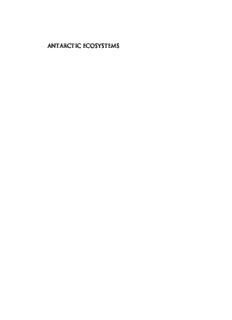
Antarctic Ecosystems: An Extreme Environment in a Changing World PDF
Preview Antarctic Ecosystems: An Extreme Environment in a Changing World
ANTARCTIC ECOSYSTEMS Antarctic Ecosystems An Extreme Environment in a Changing World Edited by Alex D. Rogers, Nadine M. Johnston, Eugene J. Murphy and Andrew Clarke OriginatingfromaThemeIssuepublishedinPhilosophicalTransactionsoftheRoyal SocietyB:BiologicalSciences. Thiseditionfirstpublished2012.Editorialmaterial(cid:2)2012byBlackwellPublishingLtd. ThisbookwasoriginallypublishedasanissueofthePhilosophicalTransactionsoftheRoyalSocietyB:Biological Sciences(Volume362,Numbers1477/January29,2007and1488/December29,2007)buthasbeen materiallychangedandupdated. BlackwellPublishingwasacquiredbyJohnWiley&SonsinFebruary2007.Blackwell’spublishingprogramhasbeenmerged withWiley’sglobalScientific,TechnicalandMedicalbusinesstoformWiley-Blackwell. Registeredoffice:JohnWiley&Sons,Ltd,TheAtrium,SouthernGate,Chichester,WestSussex,PO198SQ,UK Editorialoffices:9600GarsingtonRoad,Oxford,OX42DQ,UK TheAtrium,SouthernGate,Chichester,WestSussex,PO198SQ,UK 111RiverStreet,Hoboken,NJ07030-5774,USA Fordetailsofourglobaleditorialoffices,forcustomerservicesandforinformationabouthowtoapplyforpermissiontoreuse thecopyrightmaterialinthisbookpleaseseeourwebsiteatwww.wiley.com/wiley-blackwell. TherightoftheauthortobeidentifiedastheauthorofthisworkhasbeenassertedinaccordancewiththeUKCopyright,Designs andPatentsAct1988. Allrightsreserved.Nopartofthispublicationmaybereproduced,storedinaretrievalsystem,ortransmitted,inanyform orbyanymeans,electronic,mechanical,photocopying,recordingorotherwise,exceptaspermittedbytheUKCopyright, DesignsandPatentsAct1988,withoutthepriorpermissionofthepublisher. Designationsusedbycompaniestodistinguishtheirproductsareoftenclaimedastrademarks.Allbrandnamesandproduct namesusedinthisbookaretradenames,servicemarks,trademarksorregisteredtrademarksoftheirrespectiveowners. Thepublisherisnotassociatedwithanyproductorvendormentionedinthisbook.Thispublicationisdesignedtoprovide accurateandauthoritativeinformationinregardtothesubjectmattercovered.Itissoldontheunderstandingthatthepublisher isnotengagedinrenderingprofessionalservices.Ifprofessionaladviceorotherexpertassistanceisrequired,theservices ofacompetentprofessionalshouldbesought. LibraryofCongressCataloging-in-PublicationData Antarcticecosystems:anextremeenvironmentinachangingworld/editedbyAlexD.Rogers...[etal.]. p.cm. “OriginallypublishedasanissueofthePhilosophicalTransactionsoftheRoyalSocietyB:BiologicalSciences(Volume362, Numbers1477/January29,2007and1488/December29,2007)buthasbeenmateriallychangedandupdated.” Includesindex. ISBN978-1-4051-9840-0(cloth) 1. Ecology–Antarctica.2. Bioticcommunities–Antarctica. I.Rogers,Alex,1968- QH84.2.A5822012 577.099809–dc23 2011037209 AcataloguerecordforthisbookisavailablefromtheBritishLibrary. Setin9/11ptPhotinaMTbyThomsonDigital,Noida,India 1 2012 CONTENTS Contributors,xi 2GLOBALCHANGEINALOWDIVERSITY TERRESTRIALECOSYSTEM:THE INTRODUCTION:ANTARCTICECOLOGY MCMURDODRYVALLEYS,44 INACHANGINGWORLD,1 DianaH.Wall AndrewClarke,NadineM.Johnston,EugeneJ.Murphy 2.1 Introduction,44 andAlexD.Rogers 2.2 TheMcMurdodryvalleyregion,46 Introduction,1 2.3 Above–belowgroundinteractions,46 Climatechange,2 2.4 Thefunctioningoflowdiversitysystems,50 Thehistoricalcontext,3 2.5 Effectsofglobalchangesoncoupled Theimportanceofscale,3 above–belowgroundsubsystems,51 Fisheriesandconservation,4 2.6 Temperaturechange:warming,52 Concludingremarks,6 2.7 Temperaturechange:cooling,54 References,6 2.8 Directhumaninfluence:trampling,54 2.9 UVRadiation,55 PART1TERRESTRIALANDFRESHWATER 2.10 Concludingremarks,56 HABITATS,11 Acknowledgements,56 References,56 1SPATIALANDTEMPORALVARIABILITY INTERRESTRIALANTARCTIC 3ANTARCTICLAKESASMODELSFORTHE BIODIVERSITY,13 STUDYOFMICROBIALBIODIVERSITY, StevenL.ChownandPeterConvey BIOGEOGRAPHYANDEVOLUTION,63 1.1 Introduction,13 DavidA.PearceandJohannaLaybourn-Parry 1.2 Variationacrossspace,16 3.1 Thevarietyofantarcticlaketypes,63 1.2.1 Individualandpopulationlevels,16 3.2 Thephysicalandchemicallakeenvironment,66 1.2.2 Specieslevel,18 3.3 Themicrobialdiversityofantarcticlakes,66 1.2.3 Assemblageandecosystemlevels,20 3.3.1 MethodsforexploringAntarcticlake 1.3 Variationthroughtime,25 biodiversity,67 1.3.1 Individuallevel,26 3.3.2 Microbialgroups,69 1.3.2 Populationlevel,27 3.3.3 Protists,70 1.3.3 Specieslevel,29 3.3.4 Crustacea,72 1.3.4 Assemblageandecosystem 3.4 Biogeography,74 levels,29 3.4.1 Spatialvariationandtheglobalubiquity 1.4 Conclusionsandimplications,30 hypothesis,74 Acknowledgments,31 3.4.2 Temporalvariationand References,31 palaeolimnology,75 vi Contents 3.5 Evolution,76 5.2.1 Surfaceairtemperature,123 3.5.1 Prokaryotephysiology,76 5.2.2 Seaice,123 3.5.2 Eukaryotephysiology,77 5.2.3 Climateco-variability,125 3.6 Futureperspectives,78 5.3 Physicaloceanography,127 3.7 Acknowledgement,78 5.4 Nutrientsandcarbon,130 References,78 5.4.1 NutrientsandUCDWintrusions,130 5.4.2 Carboncycle,131 5.4.3 Dissolvedorganiccarbon,132 PART2MARINEHABITATSANDREGIONS,91 5.4.4 Sedimentationandexport,133 5.5 Phytoplanktondynamics,134 4THEIMPACTOFREGIONALCLIMATE 5.5.1 Seasonalscaledynamics,134 CHANGEONTHEMARINEECOSYSTEM 5.5.2 Roleoflight,134 OFTHEWESTERNANTARCTIC 5.5.3 Roleofnutrients,136 PENINSULA,93 5.5.4 Annualvariabilityin AndrewClarke,DavidK.A.Barnes,ThomasJ.Bracegirdle, phytoplankton,137 HughW.Ducklow,JohnC.King,MichaelP.Meredith, 5.6 Microbialecology,138 EugeneJ.MurphyandLloydS.Peck 5.7 Zooplankton,140 4.1 Introduction,93 5.7.1 Communitycomposition 4.1.1 Theoceanographicsetting,96 anddistribution,140 4.1.2 Thehistoricalcontext,97 5.7.2 Long-termtrendsand 4.2 Predictedenvironmentalchangesalongthe climateconnections,142 westernantarcticpeninsula,98 5.7.3 Grazingandbiogeochemical 4.3 Environmentalvariabilityandecological cycling,142 response,100 5.8 Penguins,143 4.3.1 Bioticresponsestoclimatechange: 5.8.1 Contaminantsinpenguins,145 somegeneralpoints,102 5.9 Marinemammals,146 4.4 Responsesofindividualmarinespeciestoclimate 5.10 Synthesis:foodwebsofthewap,147 change,102 5.11 Conclusions,148 4.4.1 Acclimationandevolutionary Acknowledgements,149 responsestoenvironmentalchange References,149 inantarcticmarineorganisms,104 4.5 Communitylevelresponsestoclimate 6SPATIALANDTEMPORALOPERATION change,106 OFTHESCOTIASEAECOSYSTEM,160 4.6 Ecosystemlevelresponsestoclimate E.J.Murphy,J.L.Watkins,P.N.Trathan,K.Reid, change,107 M.P.Meredith,S.L.Hill,S.E.Thorpe,N.M.Johnston, 4.7 Whatbiologicalchangeshavebeenobserved A.Clarke,G.A.Tarling,M.A.Collins,J.Forcada, todate?,109 A.Atkinson,P.Ward,I.J.Staniland,D.W.Pond, 4.8 Concludingremarks,110 R.A.Cavanagh,R.S.Shreeve,R.E.Korb,M.J.Whitehouse, Acknowledgements,110 P.G.Rodhouse,P.Enderlein,A.G.Hirst,A.R.Martin, References,111 D.R.Briggs,N.J.CunninghamandA.H.Fleming 6.1 Introduction,160 5THEMARINESYSTEMOFTHEWESTERN 6.2 Oceanographyandseaice,163 ANTARCTICPENINSULA,121 6.2.1 Upper-oceancirculationand HughDucklow,AndrewClarke,RebeccaDickhut,ScottC. characteristicsintheScotiaSea,163 Doney,HeidiGeisz,KuanHuang,DouglasG.Martinson, 6.2.2 Physicalvariabilityandlong-term MichaelP.Meredith,HollyV.Moeller,MartinMontes- change,167 Hugo,OscarSchofield,SharonE.Stammerjohn, 6.3 Nutrientandplanktondynamics,168 DebbieSteinbergandWilliamFraser 6.4 Krillinthescotiaseafoodweb,171 5.1 Introduction,121 6.4.1 Krilldistributioninthe 5.2 Climateandice,123 ScotiaSea,171 Contents vii 6.4.2 Krillgrowthandageinthe 8.2 Theregion,245 ScotiaSea,173 8.2.1 Theeast(80(cid:2) E–150(cid:2) E),245 6.4.3 Krillreproductionandrecruitment 8.2.2 Thewest(30(cid:2) E–80(cid:2) E),247 intheScotiaSea,174 8.3 Ecosystemchangeoffeastantarctica,251 6.4.4 Krill–habitatinteractionsinthe Summary,251 ScotiaSea,177 References,252 6.4.5 Krillpopulationvariabilityand changeintheScotiaSea,180 9THEDYNAMICMOSAIC,255 6.4.6 KrillintheScotiaSeafoodweb,183 DavidK.A.BarnesandKathleenE.Conlan 6.5 Foodweboperation,184 9.1 Introduction,255 6.5.1 Trophiclinks,184 9.2 Historicalandgeographicperspectives,256 6.5.2 Spatialoperationofthefoodweb,189 9.3 Disturbance,257 6.6 Ecosystemvariabilityandlong-term 9.3.1 Iceeffects,258 change,192 9.3.2 Asteroidimpacts,260 6.7 Concludingcomments,195 9.3.3 Sedimentinstabilityand Summary,196 hypoxia,261 Acknowledgements,197 9.3.4 Windandwaveaction,261 References,197 9.3.5 Pollution,262 9.3.6 UVirradiation,263 7THEROSSSEACONTINENTALSHELF: 9.3.7 Volcaniceruptions,263 REGIONALBIOGEOCHEMICALCYCLES, 9.3.8 Trawling,264 TROPHICINTERACTIONS,AND 9.3.9 Non-indigenousspecies(NIS),264 POTENTIALFUTURECHANGES,213 9.3.10 Freshwater,265 WalkerO.Smith,Jr.,DavidG.Ainley, 9.3.11 Temperaturestress,265 RiccardoCattaneo-ViettiandEileenE.Hofmann 9.3.12 Biologicalagentsofphysical 7.1 Introduction,213 disturbance,266 7.2 Physicalsetting,214 9.4 Colonisatonofantarcticsea-beds,266 7.3 Biologicalsetting,219 9.4.1 Larvalabundance,266 7.3.1 Lowertrophiclevels,219 9.4.2 Hardsubstrata,266 7.3.2 Mid-trophiclevels,225 9.4.3 Softsediments,269 7.3.3 Fishesandmobilepredators,226 9.5 Implicationsofclimatechange,276 7.3.4 Uppertrophiclevels,227 9.6 Conclusion,279 7.3.5 Benthos,229 Acknowledgements,280 7.4 Foodwebandbioticinteractions,230 References,281 7.5 Conclusions,232 7.5.1 UniquenessoftheRossSea,232 10SOUTHERNOCEANDEEPBENTHIC 7.5.2 Potentialimpactsofclimate BIODIVERSITY,291 change,233 A.Brandt,C.DeBroyer,B.Ebbe,K.E.Ellingsen, 7.5.3 Conservationandtheroleof A.J.Gooday,D.Janussen,S.Kaiser,K.Linse,M.Schueller, commercialfishingactivityinthe M.R.A.Thomson,P.A.TylerandA.Vanreusel RossSea,234 10.1 Introduction,291 7.5.4 Researchneedsandfuture 10.2 Historyofantarcticbiodiversity directions,235 work,293 Acknowledgements,235 10.3 Geologicalhistoryandevolutionofthe References,235 antarctic,294 10.3.1 IndianOcean,294 8PELAGICECOSYSTEMSINTHEWATERS 10.3.2 SouthAtlantic,294 OFFEASTANTARCTICA(30(cid:2) E–150(cid:2) E),243 10.3.3 WeddellSea,295 StephenNicolandBenRaymond 10.3.4 DrakePassageandScotia 8.1 Introduction,243 Sea,296 viii Contents 10.4 Benthiccompositionanddiversityof 11ENVIRONMENTALFORCINGAND meio-,macro-andmegabenthos,296 SOUTHERNOCEANMARINEPREDATOR 10.4.1 Meiofauna,297 POPULATIONS,335 10.4.2 Macrofaunalcomposition PhilN.Trathan,JaumeForcadaandEugeneJ.Murphy anddiversity,299 11.1 Climatechange:recent,rapid,regional 10.4.3 Megafaunalcomposition warming,335 anddiversity,304 11.2 Usingoscillatoryclimatesignalstopredict 10.5 Phylogeneticrelationshipsofselected futurechangeinbiologicalcommunities,337 taxa,308 11.3 Potentialforregionalimpactsonthe 10.5.1 Foraminifera,308 biosphere,338 10.5.2 Isopoda,308 11.4 Confoundingisuesinidentifyingabiological 10.5.3 Tanaidacea,309 signal,339 10.5.4 Bivalvia,310 11.5 Regionalecosystemresponsesasa 10.5.5 Polychaeta,310 consequenceofvariationinregionalfood 10.5.6 Cephalopoda,310 webs,340 10.6 Biogeographyandendemism,311 11.6 Wherebiologicalsignalswillbemost 10.6.1 Porifera,311 apparent,340 10.6.2 Foraminifera,311 11.7 Thesouthwestatlantic,341 10.6.3 Metazoanmeiofauna,311 11.8 Theindianocean,344 10.6.4 Peracarida,312 11.9 Thepacificocean,345 10.6.5 Mollusca,312 11.10 Similaritiesbetweentheatlantic,indian 10.6.6 Echinodermata,313 andpacificoceans,346 10.6.7 Brachiopoda,313 11.11 WhatENSOcantellus,347 10.6.8 Polychaeta,313 11.12 Futurescenarios,349 10.6.9 Bryozoa,313 References,349 10.7 Relationshipofselectedfaunal assemblagestoenvironmental variables,313 PART3MOLECULARADAPTATIONS 10.7.1 Large-scalepatternswith ANDEVOLUTION,355 depth,313 10.7.2 Patternsinfluencedbyother 12MOLECULARECOPHYSIOLOGYOF environmentalorphysical ANTARCTICNOTOTHENIOIDFISHES(cid:3),357 factors,317 C.-H.ChristinaChengandH.WilliamDetrichIII 10.7.3 Isopoda,318 12.1 Introduction,357 10.8 Similaritiesanddifferencesbetween 12.2 Survivingthebigchill–notothenioid antarcticandotherdeep-sea freezingavoidancebyantifreeze systems,318 proteins,358 10.8.1 Theenvironment,318 12.2.1 FreezingchallengeinfrigidAntarctic 10.8.2 Adirectcomparisonbetweenthe marineenvironment,358 deepseaoftheSOandtheWorld 12.2.2 Historicalparadigmofteleostfreezing Ocean,319 avoidance,360 10.8.3 Dispersalandrecruitmentbetween 12.2.3 ParadigmshiftI:the‘larval theSOandtherestofthe paradox’,360 world,320 12.2.4 ParadigmshiftII:liverisnotthe 10.8.4 Thespecialcaseof sourceofbloodAFGPin chemosynthetically-driven notothenioids,362 deep-seasystems,320 12.2.5 Gutversusblood–importanceof 10.9 Conclusions,321 intestinalfreezeavoidance,363 Acknowledgements,321 12.2.6 Non-hepaticsourceofplasma References,323 AFGP,364 Contents ix 12.2.7 Alterationsinenvironmentsand 13.2.5 Ecologicalimplications,399 dynamicevolutionarychange 13.2.6 Integrationofphenomena:concepts, innotothenioidAFGPgene resultsandperspectives,405 families,364 Acknowledgements,409 12.2.8 Summarycomments–antifreeze References,409 proteingaininAntarctic notothenioidfish,367 14EVOLUTIONANDBIODIVERSITY 12.3 Haemoproteinlossandcardiovascular OFANTARCTICORGANISMS,417 adaptationinicefishes–dr.notothe AlexD.Rogers rescue?,367 14.1 Introduction,417 12.3.1 Vertebrateswithouthaemoglobins– 14.2 Theantarcticbiota,418 youmustbekidding!,367 14.3 Thebreak-upofgondwanaandthe 12.3.2 Haemoproteinlossinicefishes:an evolutionofthesouthernhemisphere evolutionaryperspective,368 biota,420 12.3.3 Cellularcorrelatesof 14.3.1 Vicarianceversusdispersal,420 haemoproteinloss,370 14.3.2 Dispersalmechanisms,421 12.3.4 Theicefishcardiovascular 14.4 Theevolutionandbiodiversityoftheterrestrial system,371 sub-antarcticandantarcticbiota,423 12.3.5 Compensatoryadjustment 14.4.1 Plants,423 oftheicefishcardiovascularsystem 14.4.2 Animals,427 inaregimeofreducedinterspecific 14.5 Themarineenvironment,432 competition?EnterDr.NO,371 14.5.1 Biogeographyandmacroevolution, 12.3.6 Haemoproteins,NOmetabolism, 432 andicefishevolution,372 14.5.2 Notothenioidfish,432 12.3.7 Icefishesanderythropoieticgene 14.5.3 Birds,435 discovery,372 14.5.4 Marineinvertebrates,436 12.3.8 Summarycomments:haemoprotein 14.5.5 Themolecularecologyand lossinAntarcticicefishes,374 phylogeographyofthemarinebiota, 12.4 Concludingremarks,374 437 Acknowledgements,374 14.5.6 Patternsofgeneticvariation Dedication,374 inmarinespecies,448 References,374 14.6 Antarctica:aclimaticcrucible ofevolution,450 13MECHANISMSDEFININGTHERMALLIMITS 14.7 Thehistoricalconstraintsonadaptation ANDADAPTATIONINMARINEECTOTHERMS: topresentclimatechange,453 ANINTEGRATIVEVIEW,379 14.8 Futuredirectionsforresearch,453 HansO.Po€rtner,LloydS.PeckandGeorgeN.Somero References,454 13.1 Introduction:climate-dependentevolution ofantarcticfauna,379 13.2 Phenomenaofthermalspecialization PART4CONSERVATIONANDMANAGEMENT andlimitation,382 ASPECTS,469 13.2.1 Molecularandmembrane aspects,383 15BIOGEOGRAPHYANDREGIONAL 13.2.2 Genomicaspects:geneexpression CLASSIFICATIONSOFANTARCTICA,471 andlossofgeneticinformation,390 P.Convey,D.K.A.Barnes,H.J.Griffiths,S.M.Grant, 13.2.3 Frommoleculartosystemicaspects: K.LinseandD.N.Thomas thermallimitation,393 15.1 Introduction,471 13.2.4 Frommoleculartosystemicaspects: 15.2 Historicalbackground,474 thermaladaptationofperformance 15.2.1 Physicalregionsinthemarine capacity,397 environment,474 x Contents 15.2.2 Smaller-scaleregionalization 16.2 Legalframeworksforconservation withintheAntarcticmarine andmanagement,495 environment,474 16.2.1 Earlyregulationofmarineliving 15.2.3 Physicalregionsinthelittoral resourceharvesting,495 environment,475 16.2.2 TheAntarcticTreatySystem,497 15.2.4 Physicalregionsintheterrestrial 16.2.3 Other(non-ATS)agreements environment,475 andtoolsrelevanttoconservation 15.3 Dataavailability,476 andmanagement,500 15.4 Differentrealmsinthemarineandterrestrial 16.3 Conservationandmanagement environments,477 measures,502 15.4.1 Pelagicrealm,477 16.3.1 Pollutionandlocal 15.4.2 Seaice,478 disturbance,502 15.4.3 Benthicrealm,479 16.3.2 Biosecurityandnon-native 15.4.4 Theterrestrialenvironment,479 species,505 15.4.5 Biogeographicalpatternsinthe 16.3.3 Conservationandmanagement terrestrialenvironment,480 ofmarinelivingresources,505 15.4.6 Biogeographicpatternsinthe 16.3.4 Conservationofotherindividual marineenvironment,481 species,507 15.5 Overview,485 16.3.5 Protectedareas,509 Acknowledgements,486 16.4 Conservationscienceand References,486 monitoring,512 16.5 Futurechallenges,515 16CONSERVATIONANDMANAGEMENT 16.6Conclusions,520 OFANTARCTICECOSYSTEMS,492 Acknowledgements,521 SusieM.Grant,PeteConvey,KevinA.Hughes, References,521 RichardA.PhillipsandPhilN.Trathan 16.1 Introduction,492 Index,526 Contributors DavidG.Ainley C.-H.ChristinaCheng H.T.HarveyandAssociates,3150AlmadenExpressway, Department of Animal Biology, University of Illinois, SanJose,CA95118 515MorrillHall,Urbana,IL61801,USA AngusAtkinson AndrewClarke BritishAntarcticSurvey,NERC,HighCross,Madingley BritishAntarcticSurvey,NERC,HighCross,Madingley Road,CambridgeCB30ET,UK Road,CambridgeCB30ET,UK DavidK.A.Barnes MartinA.Collins BritishAntarcticSurvey,NERC,HighCross,Madingley Government House, Stanley, Falkland Islands, South Road,CambridgeCB30ET,UK Atlantic ThomasJ.Bracegirdle KathleenE.Conlan BritishAntarcticSurvey,NERC,HighCross,Madingley CanadianMuseumofNature,POBox3443,StationD, Road,CambridgeCB30ET,UK Ottawa,OntarioK1P6P4,Canada AngelikaBrandt PeterConvey Biocentre Grindel and Zoological Museum, Martin- BritishAntarcticSurvey,HighCross,MadingleyRoad, Luther-King-Platz3,20146Hamburg,Germany Cambridge,CB30ET,UK D.R.Briggs NathanCunningham BritishAntarcticSurvey,NERC,HighCross,Madingley BritishAntarcticSurvey,NERC,HighCross,Madingley Road,CambridgeCB30ET,UK Road,CambridgeCB30ET,UK RiccardoCattaneo-Vietti ClaudeDeBroyer Dipartimento per lo Studio del Territorio e delle sue Institut Royal des Sciences Naturelles de Belgique, Risorse,Universit(cid:2)adiGenova,16132Genova RueVautier29,1000Bruxelles,Belgium RachelA.Cavanagh H.WilliamDetrichIII BritishAntarcticSurvey,NERC,HighCross,Madingley Department of Biology, Northeastern University, 134 Road,CambridgeCB30ET,UK MugarHall,Boston,MA02115,USA StevenL.Chown RebeccaDickhut Centre for Invasion Biology, Department of Botany & VirginiaInstuteofMarineScience,CollegeofWilliam Zoology, Stellenbosch University, Private Bag X1, andMary,GloucesterPoint,VAUSA Matieland7602,SouthAfrica
Description: